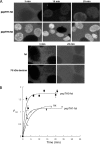Probing the specificity of binding to the major nuclear localization sequence-binding site of importin-alpha using oriented peptide library screening
- PMID: 20406804
- PMCID: PMC2888405
- DOI: 10.1074/jbc.M109.079574
Probing the specificity of binding to the major nuclear localization sequence-binding site of importin-alpha using oriented peptide library screening
Abstract
Importin-alpha is the nuclear import receptor that recognizes the classic monopartite and bipartite nuclear localization sequences (cNLSs), which contain one or two clusters of basic amino acids, respectively. Different importin-alpha paralogs in a single organism are specific for distinct repertoires of cargos. Structural studies revealed that monopartite cNLSs and the C-terminal basic clusters of the bipartite cNLSs bind to the same site on importin-alpha, termed the major cNLS-binding site. We used an oriented peptide library approach with five degenerate positions to probe the specificity of the major cNLS-binding site in importin-alpha. We identified the sequences KKKRR, KKKRK, and KKRKK as the optimal sequences for binding to this site for mouse importin-alpha2, human importin-alpha1, and human importin-alpha5, respectively. The crystal structure of mouse importin-alpha2 with its optimal peptide confirmed the expected binding mode resembling the binding of simian virus 40 large tumor-antigen cNLS. Binding assays confirmed that the peptides containing these sequences bound to the corresponding proteins with low nanomolar affinities. Nuclear import assays showed that the sequences acted as functional cNLSs, with specificity for particular importin-alphas. This is the first time that structural information has been linked to an oriented peptide library screening approach for importin-alpha; the results will contribute to understanding of the sequence determinants of cNLSs, and may help identify as yet unidentified cNLSs in novel proteins.
Figures





Similar articles
-
Structural basis of high-affinity nuclear localization signal interactions with importin-α.Traffic. 2012 Apr;13(4):532-48. doi: 10.1111/j.1600-0854.2012.01329.x. Epub 2012 Feb 7. Traffic. 2012. PMID: 22248489
-
A functional and structural comparative analysis of large tumor antigens reveals evolution of different importin α-dependent nuclear localization signals.Protein Sci. 2024 Feb;33(2):e4876. doi: 10.1002/pro.4876. Protein Sci. 2024. PMID: 38108201 Free PMC article.
-
Role of flanking sequences and phosphorylation in the recognition of the simian-virus-40 large T-antigen nuclear localization sequences by importin-alpha.Biochem J. 2003 Oct 15;375(Pt 2):339-49. doi: 10.1042/BJ20030510. Biochem J. 2003. PMID: 12852786 Free PMC article.
-
Molecular basis for specificity of nuclear import and prediction of nuclear localization.Biochim Biophys Acta. 2011 Sep;1813(9):1562-77. doi: 10.1016/j.bbamcr.2010.10.013. Epub 2010 Oct 25. Biochim Biophys Acta. 2011. PMID: 20977914 Review.
-
Diversification of importin-α isoforms in cellular trafficking and disease states.Biochem J. 2015 Feb 15;466(1):13-28. doi: 10.1042/BJ20141186. Biochem J. 2015. PMID: 25656054 Free PMC article. Review.
Cited by
-
Multiple types of nuclear localization signals in Entamoeba histolytica.Biochem Biophys Rep. 2024 Jul 4;39:101770. doi: 10.1016/j.bbrep.2024.101770. eCollection 2024 Sep. Biochem Biophys Rep. 2024. PMID: 39055170 Free PMC article.
-
Molecular basis for the recognition of phosphorylated STAT1 by importin alpha5.J Mol Biol. 2010 Sep 10;402(1):83-100. doi: 10.1016/j.jmb.2010.07.013. Epub 2010 Jul 17. J Mol Biol. 2010. PMID: 20643137 Free PMC article.
-
Acetylation accumulates PFKFB3 in cytoplasm to promote glycolysis and protects cells from cisplatin-induced apoptosis.Nat Commun. 2018 Feb 6;9(1):508. doi: 10.1038/s41467-018-02950-5. Nat Commun. 2018. PMID: 29410405 Free PMC article.
-
The importin β binding domain as a master regulator of nucleocytoplasmic transport.Biochim Biophys Acta. 2011 Sep;1813(9):1578-92. doi: 10.1016/j.bbamcr.2010.10.012. Epub 2010 Oct 26. Biochim Biophys Acta. 2011. PMID: 21029753 Free PMC article. Review.
-
Recognition of nuclear targeting signals by Karyopherin-β proteins.Curr Opin Struct Biol. 2010 Dec;20(6):782-90. doi: 10.1016/j.sbi.2010.09.008. Epub 2010 Oct 13. Curr Opin Struct Biol. 2010. PMID: 20951026 Free PMC article. Review.
References
-
- Aitchison J. D., Wozniak R. W. (2007) Nature 450, 621–622 - PubMed
-
- Alber F., Dokudovskaya S., Veenhoff L. M., Zhang W., Kipper J., Devos D., Suprapto A., Karni-Schmidt O., Williams R., Chait B. T., Sali A., Rout M. P. (2007) Nature 450, 695–701 - PubMed
-
- Kobe B., Kajava A. V. (2000) Trends Biochem. Sci. 25, 509–515 - PubMed
-
- Cingolani G., Petosa C., Weis K., Müller C. W. (1999) Nature 399, 221–229 - PubMed
Publication types
MeSH terms
Substances
Associated data
- Actions
LinkOut - more resources
Full Text Sources

